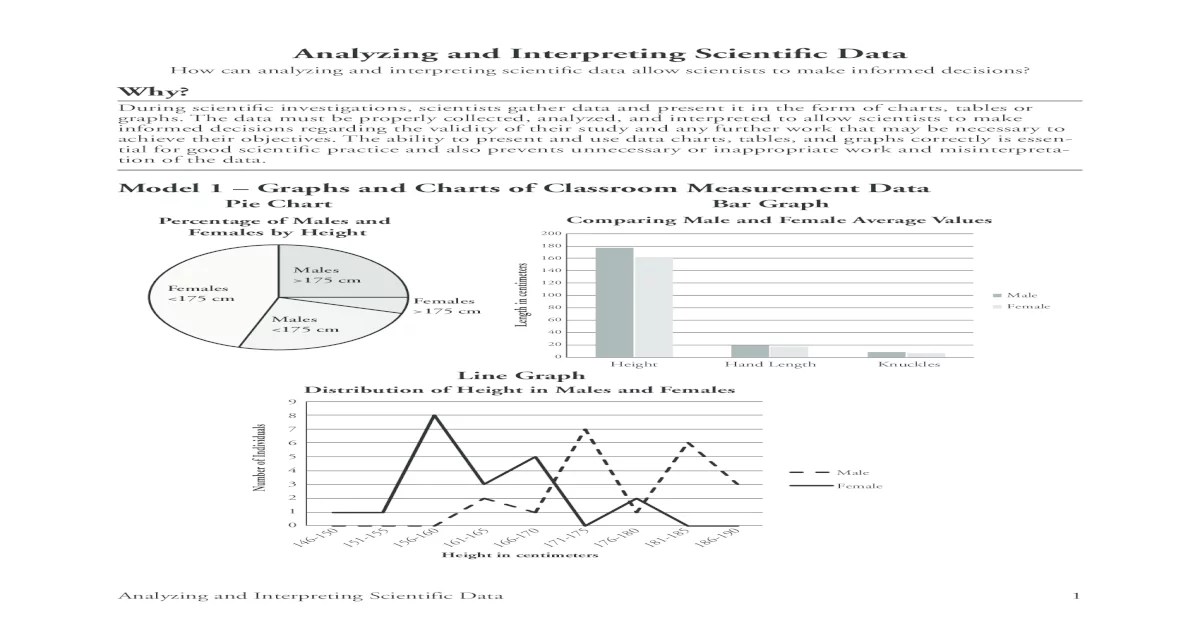Delving into the realm of analyzing and interpreting scientific data answers, this comprehensive guide embarks on a journey to unveil the intricacies of data exploration, statistical analysis, machine learning, and ethical considerations. Brace yourself for an enlightening expedition into the world of scientific data!
Through this exploration, we will uncover the techniques and methods employed to collect and prepare scientific data for analysis, emphasizing the significance of data cleaning, transformation, and normalization. Moreover, we will delve into the captivating world of data visualization, showcasing its power in exploring and comprehending complex datasets.
1. Data Collection and Preparation: Analyzing And Interpreting Scientific Data Answers
Analyzing and interpreting scientific data requires careful collection and preparation. Data collection methods vary depending on the research question and data type. Researchers may use surveys, experiments, observations, or data mining techniques to gather data. Data preparation involves cleaning, transforming, and normalizing the data to ensure its accuracy and consistency.
Data visualization techniques, such as graphs, charts, and tables, are essential for exploring and understanding the data. These visualizations help researchers identify patterns, trends, and outliers, and make informed decisions about further analysis.
Data Cleaning
- Remove duplicate data points.
- Handle missing values by imputation or exclusion.
- Correct errors and inconsistencies.
Data Transformation
- Convert data to a consistent format.
- Rescale or normalize data to improve comparability.
- Create new variables or features.
Data Normalization
- Bring data to a common scale.
- Improve the interpretability of results.
- Prepare data for statistical analysis.
Data Visualization Techniques
- Histograms: Display the distribution of data.
- Scatterplots: Show the relationship between two variables.
- Box plots: Summarize the distribution and outliers.
- Heatmaps: Visualize the relationships between multiple variables.
2. Statistical Analysis

Statistical analysis provides methods for analyzing and interpreting scientific data. Descriptive statistics summarize the data, while inferential statistics make inferences about the population from which the data was drawn.
Hypothesis testing is a fundamental concept in statistical analysis. Researchers formulate a hypothesis and test it using statistical methods to determine if there is sufficient evidence to support or reject the hypothesis.
Descriptive Statistics
- Measures of central tendency: Mean, median, mode.
- Measures of dispersion: Variance, standard deviation.
- Graphical representations: Histograms, box plots.
Inferential Statistics
- Hypothesis testing: Null hypothesis, alternative hypothesis, p-value.
- Confidence intervals: Estimate the population parameter with a certain level of confidence.
- Regression analysis: Model the relationship between a dependent variable and one or more independent variables.
Hypothesis Testing, Analyzing and interpreting scientific data answers
- Set up a null hypothesis and alternative hypothesis.
- Calculate the test statistic.
- Determine the p-value.
- Make a decision: Reject or fail to reject the null hypothesis.
3. Machine Learning and Data Mining
Machine learning and data mining are powerful tools for analyzing and interpreting scientific data. Machine learning algorithms can learn from data and make predictions or classifications.
Data mining techniques can identify patterns and extract insights from large datasets. These methods have applications in various scientific fields, such as medicine, biology, and social sciences.
Machine Learning Algorithms
- Supervised learning: Learn from labeled data.
- Unsupervised learning: Learn from unlabeled data.
- Reinforcement learning: Learn through trial and error.
Data Mining Techniques
- Clustering: Group data points into similar clusters.
- Association rule mining: Discover relationships between items in a dataset.
- Classification: Predict the class label of new data points.
Applications in Scientific Research
- Disease diagnosis and prediction.
- Drug discovery and development.
- Financial forecasting.
4. Data Visualization and Communication

Effective data visualization is crucial for communicating scientific findings to a variety of audiences. Different types of data visualization techniques are suitable for different types of data and purposes.
Researchers should consider the following principles when designing data visualizations: clarity, accuracy, simplicity, and relevance.
Principles of Effective Data Visualization
- Use clear and concise labels.
- Choose appropriate chart types.
- Highlight important patterns and trends.
- Avoid clutter and unnecessary elements.
Types of Data Visualization Techniques
- Graphs: Line graphs, bar graphs, pie charts.
- Charts: Scatterplots, histograms, box plots.
- Maps: Geographic visualizations.
- Interactive visualizations: Dashboards, data exploration tools.
Communicating Scientific Findings
- Tailor visualizations to the audience.
- Provide context and explanations.
- Use visuals to support arguments and conclusions.
5. Data Ethics and Responsible Interpretation
Analyzing and interpreting scientific data involves ethical considerations. Researchers must ensure data privacy, confidentiality, and avoid bias.
Responsible data interpretation requires transparency, replicability, and open access to data and methods.
Data Ethics
- Protect data privacy and confidentiality.
- Avoid biased data collection and analysis.
- Obtain informed consent when collecting data from human subjects.
Responsible Data Interpretation
- Be transparent about data sources and methods.
- Replicate results and encourage independent verification.
- Make data and code publicly available.
Guidelines for Responsible Interpretation
- Avoid overinterpreting results.
- Consider alternative explanations.
- Communicate findings accurately and without bias.
Helpful Answers
What is the significance of data cleaning in scientific data analysis?
Data cleaning plays a crucial role in ensuring the accuracy and reliability of scientific data. It involves removing errors, inconsistencies, and outliers, which can potentially skew analysis results. By cleaning the data, researchers can enhance the quality of their analysis and draw more meaningful conclusions.
How can machine learning contribute to analyzing scientific data?
Machine learning algorithms excel in identifying patterns and extracting insights from complex scientific data. They can automate data analysis tasks, uncover hidden relationships, and make predictions based on historical data. By leveraging machine learning, researchers can accelerate their data analysis process and gain deeper insights into their research.
What ethical considerations should be taken into account when analyzing scientific data?
Ethical considerations are paramount in scientific data analysis. Researchers must ensure data privacy and confidentiality, avoiding any potential harm to individuals or groups. They should also be mindful of potential biases that may arise during data collection and analysis, striving to maintain objectivity and transparency throughout the research process.